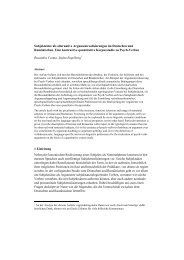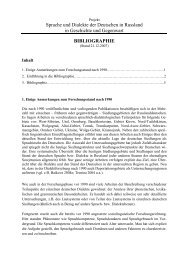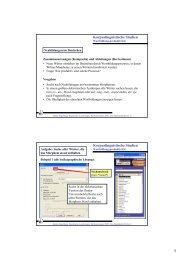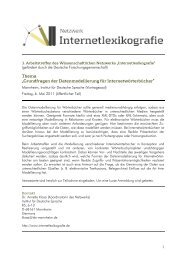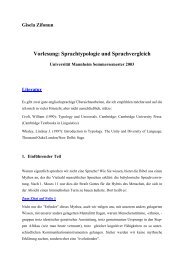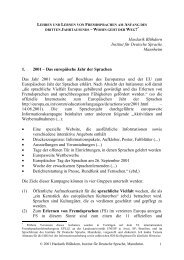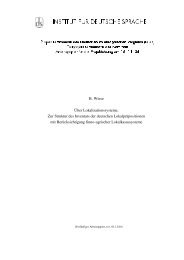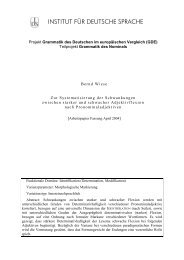Subordination and coordination in syntax, semantics and discourse ...
Subordination and coordination in syntax, semantics and discourse ...
Subordination and coordination in syntax, semantics and discourse ...
You also want an ePaper? Increase the reach of your titles
YUMPU automatically turns print PDFs into web optimized ePapers that Google loves.
Hardarik BlühdornThe dist<strong>in</strong>ction between semantically symmetrical <strong>and</strong> asymmetric connectionscan be made with<strong>in</strong> the boundaries of the sentence (on <strong>in</strong>tra-sentence level) <strong>and</strong>also between sentences <strong>in</strong> <strong>discourse</strong> (on <strong>in</strong>ter-sentence level). Both k<strong>in</strong>ds ofsemantic connection can be encoded by coord<strong>in</strong>ators as well as by subord<strong>in</strong>ators<strong>and</strong> also by adverbial connectives. Some further examples may illustrate thispo<strong>in</strong>t:(19a) Das ist ke<strong>in</strong> Selbstbedienungsladen, und sonntags ist hier zu.[this is no self-service store, <strong>and</strong> on Sundays we are closed](19b) Sonntags ist hier zu, und das ist ke<strong>in</strong> Selbstbedienungsladen.[on Sundays we are closed, <strong>and</strong> this is no self-service store](19c) Das ist ke<strong>in</strong> Selbstbedienungsladen. Außerdem ist hier sonntags zu.[this is no self-service store. also, on Sundays we are closed](19d) Sonntags ist hier zu. Außerdem ist das ke<strong>in</strong> Selbstbedienungsladen.[on Sundays we are closed. also, this is no self-service store]The connections <strong>in</strong> (19a-d) are symmetrical. The sequence of their relata can be<strong>in</strong>verted without a significant change of mean<strong>in</strong>g. In (19a/b), the connection isencoded by a coord<strong>in</strong>ator (<strong>in</strong>tra-sentence level); <strong>in</strong> (19c/d), a semanticallyequivalent connection is encoded by an adverbial connective (<strong>in</strong>ter-sentencelevel). My argument for consider<strong>in</strong>g <strong>coord<strong>in</strong>ation</strong> of two ma<strong>in</strong> clauses an <strong>in</strong>trasentenceconnection is the syntactic constra<strong>in</strong>t on the position of the coord<strong>in</strong>ator,discussed <strong>in</strong> section 2. In addition, we can consider punctuation <strong>and</strong> <strong>in</strong>tonation.Coord<strong>in</strong>ated ma<strong>in</strong> clauses may be separated by a comma <strong>in</strong>stead of a period <strong>and</strong>may even not be separated by any punctuation mark. In spoken utterances, theycan be <strong>in</strong>cluded <strong>in</strong>to the same <strong>in</strong>tonational phrase.(20a) Wenn du ke<strong>in</strong>e Lust hast (L), gehe ich alle<strong>in</strong> (T).[if you don’t feel like it (L), I’ll go on my own (T)](20b) Wenn ich alle<strong>in</strong> gehe (L), hast du ke<strong>in</strong>e Lust (T).[if I go on my own (L), you won’t feel like it (T)](20c) Du hast ke<strong>in</strong>e Lust? (L) Dann gehe ich alle<strong>in</strong>. (T)[you don’t feel like it? (L) then I’ll go on my own (T)](20d) Ich gehe alle<strong>in</strong>? (L) Dann hast du ke<strong>in</strong>e Lust. (T)[I’ll go on my own? (L) then you won’t feel like it (T)]The examples <strong>in</strong> (20a-d) illustrate asymmetric connections. Invert<strong>in</strong>g thesequence of their relata leads to a significant change of mean<strong>in</strong>g. Theconnections <strong>in</strong> (20a/b) are encoded by a subord<strong>in</strong>ator (<strong>in</strong>tra-sentence level). In(20c/d), semantically equivalent connections are encoded by an adverbialconnective (<strong>in</strong>ter-sentence level).16© 2007 Hardarik Blühdorn, Institut für Deutsche Sprache, Mannheim.


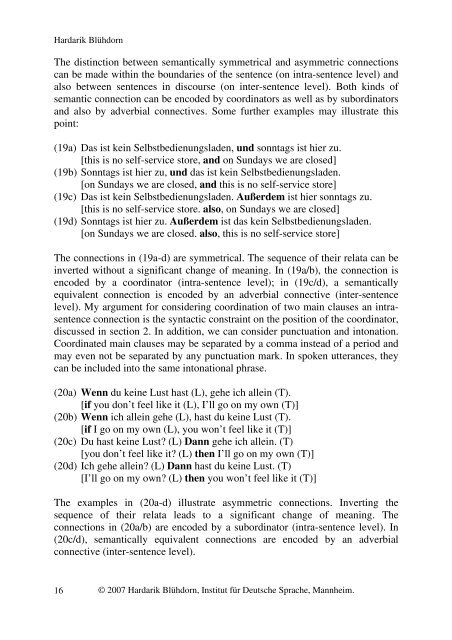
![Ãœbersetzungen-19[1]. - Institut für Deutsche Sprache](https://img.yumpu.com/51701205/1/184x260/aoebersetzungen-191-institut-fur-deutsche-sprache.jpg?quality=85)


